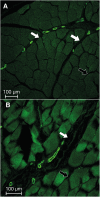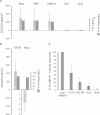Fascia Is Able to Actively Contract and May Thereby Influence Musculoskeletal Dynamics: A Histochemical and Mechanographic Investigation
- PMID: 31001134
- PMCID: PMC6455047
- DOI: 10.3389/fphys.2019.00336
Fascia Is Able to Actively Contract and May Thereby Influence Musculoskeletal Dynamics: A Histochemical and Mechanographic Investigation
Abstract
Fascial tissues form a ubiquitous network throughout the whole body, which is usually regarded as a passive contributor to biomechanical behavior. We aimed to answer the question, whether fascia may possess the capacity for cellular contraction which, in turn, could play an active role in musculoskeletal mechanics. Human and rat fascial specimens from different body sites were investigated for the presence of myofibroblasts using immunohistochemical staining for α-smooth muscle actin (n = 31 donors, n = 20 animals). In addition, mechanographic force registrations were performed on isolated rat fascial tissues (n = 8 to n = 18), which had been exposed to pharmacological stimulants. The density of myofibroblasts was increased in the human lumbar fascia in comparison to fasciae from the two other regions examined in this study: fascia lata and plantar fascia [H(2) = 14.0, p < 0.01]. Mechanographic force measurements revealed contractions in response to stimulation by fetal bovine serum, the thromboxane A2 analog U46619, TGF-β1, and mepyramine, while challenge by botulinum toxin type C3-used as a Rho kinase inhibitor- provoked relaxation (p < 0.05). In contrast, fascial tissues were insensitive to angiotensin II and caffeine (p < 0.05). A positive correlation between myofibroblast density and contractile response was found (r s = 0.83, p < 0.001). The hypothetical application of the registered forces to human lumbar tissues predicts a potential impact below the threshold for mechanical spinal stability but strong enough to possibly alter motoneuronal coordination in the lumbar region. It is concluded that tension of myofascial tissue is actively regulated by myofibroblasts with the potential to impact active musculoskeletal dynamics.
Keywords: connective tissue; contractility; contracture; myofibroblasts; stiffness.
Figures






Similar articles
-
Active contractile properties of fascia.Clin Anat. 2019 Oct;32(7):891-895. doi: 10.1002/ca.23391. Epub 2019 May 2. Clin Anat. 2019. PMID: 31012158 Review.
-
Active fascial contractility: Fascia may be able to contract in a smooth muscle-like manner and thereby influence musculoskeletal dynamics.Med Hypotheses. 2005;65(2):273-7. doi: 10.1016/j.mehy.2005.03.005. Med Hypotheses. 2005. PMID: 15922099
-
Passive muscle stiffness may be influenced by active contractility of intramuscular connective tissue.Med Hypotheses. 2006;66(1):66-71. doi: 10.1016/j.mehy.2005.08.025. Epub 2005 Oct 4. Med Hypotheses. 2006. PMID: 16209907
-
Clinical relevance of fascial tissue and dysfunctions.Curr Pain Headache Rep. 2014;18(8):439. doi: 10.1007/s11916-014-0439-y. Curr Pain Headache Rep. 2014. PMID: 24962403 Review.
-
Contractile elements in muscular fascial tissue - implications for in-vitro contracture testing for malignant hyperthermia.Anaesthesia. 2014 Sep;69(9):1002-8. doi: 10.1111/anae.12752. Epub 2014 Jun 9. Anaesthesia. 2014. PMID: 24909539
Cited by
-
Evidence of Renin-Angiotensin System Receptors in Deep Fascia: A Role in Extracellular Matrix Remodeling and Fibrogenesis?Biomedicines. 2022 Oct 17;10(10):2608. doi: 10.3390/biomedicines10102608. Biomedicines. 2022. PMID: 36289870 Free PMC article.
-
The Fascial Breath.Cureus. 2019 Jul 23;11(7):e5208. doi: 10.7759/cureus.5208. Cureus. 2019. PMID: 31565613 Free PMC article. Review.
-
The Relationship Between Acute Exercise-Induced Changes in Extramuscular Connective Tissue Thickness and Delayed Onset Muscle Soreness in Healthy Participants: A Randomized Controlled Crossover Trial.Sports Med Open. 2022 Apr 28;8(1):57. doi: 10.1186/s40798-022-00446-7. Sports Med Open. 2022. PMID: 35482217 Free PMC article.
-
Ankle Motion Is Associated With Soft Tissue Displacement in the Dorsal Thigh: An in vivo Investigation Suggesting Myofascial Force Transmission Across the Knee Joint.Front Physiol. 2020 Mar 6;11:180. doi: 10.3389/fphys.2020.00180. eCollection 2020. Front Physiol. 2020. PMID: 32210836 Free PMC article.
-
Reliability of a New Indentometer Device for Measuring Myofascial Tissue Stiffness.J Clin Med. 2022 Sep 1;11(17):5194. doi: 10.3390/jcm11175194. J Clin Med. 2022. PMID: 36079124 Free PMC article.
References
LinkOut - more resources
Full Text Sources
Miscellaneous

